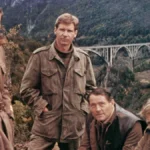KILLERS OF THE FLOWER MOON. Lynch and Clinch [REVIEW]

Military service did not bypass Ernest Burkhart (Leonardo DiCaprio). However, he did not have to get wet in the trenches on the First World War, but luckily found shelter in a field kitchen. After the armistice, he returns to the country and his hometown of Fairfax, Oklahoma. Here waiting for him is his older brother Bryan (Scott Shepard) and his uncle – William Hale (Robert De Niro) – a wealthy rancher and influential businessman with an unquenchable desire to increase his capital. If it’s legal, that’s fine. As for circumventing the law, there is no other way. Ernest needs stability, but even more the feeling of reassuring rustle of banknotes in his pocket. From the first meeting, William manipulates his nephew and treats him like a pawn in the game. The more so that there are thick millions of black gold up for grabs. Expansion into this market would not be a major problem if it were not for the Osages, who have rights to oil-bearing areas. So William must put a stop to colonization, submit to the indigenous people and accept a place in the ranks. This order can only be reversed by the carnage planned for years.
It is difficult to find a more effective bait in this case than the director’s name, but recent entries in Martin Scorsese’s filmography may have sown a seed of doubt. The epicness of The Silence or The Irishman was mainly evidenced by the exhaustive length, not the exhaustive approach to the subject. Killers of the Flower Moon, however, is a cinema of a completely different calibre. The three-and-a-half-hour saga is filled to the brim with threads and digressions, variability of perspectives and a broad view of the entire environment, shifting from total plans to intimate tragedies, seeping toxic ferment and emotional calculation into all relationships. Scorsese looks at Osage communities with undisguised tenderness. For their rituals, beliefs, and steadfastness. The director draws a black and white world in front of us, skeptical about any chance of assimilation and mutual understanding. Huge class differences, economic disproportion and envy in the purest sense do not allow it.

In the foreground, we follow the emerging feeling between Ernest and Mollie Kyle (Lily Gladstone), a pure-blooded Indian woman and direct heiress to a huge fortune. On the one hand, it’s a believable love story, on the other, a trick planned by my uncle. Marriage, hastening the death of a loved one and inheriting land. This is the way. This is no longer a precedent, but a proven tactic. Mollie, however, is a character that is difficult to outsmart. She plays a leading role, keeping Ernest at bay and maintaining a healthy caution, while intellectually superior to the uncouth veteran. The latter, in turn, is convinced of his worth and that he is “tough”. The truth is, however, that he is still a lunatic and a bully, but he can strike a slightly more romantic tone and inspire confidence in himself. At the same time, he is very susceptible to his uncle’s suggestions and unable to say “no” to anyone. Ernest has a broken value system and emotional instability, constantly lost and unconscious. Sincere declarations of love are intertwined with night robberies.
Related:
Leonardo DiCaprio thus delivers one of the most psychologically complex roles of his career. Made of paradoxes and contradictions, desires and fears, dreams and fears. It is impossible to like or completely delete it. Between Ernest and Mollie there is William, rotten to the core, corrupt and sinister in nature, but with the image of a kind grandfather. Each time he fights to gain an advantage over someone: through blackmail, deceit or lies told with a hearty smile. It doesn’t matter if the conversation partner is a sheriff, a businessman or a close family member. All three will definitely remind us of themselves every now and then during the awards season.

Killers of the Flower Moon functions at the intersection of several genres and aesthetics. Martin Scorsese sometimes uses the convention of film reportage, the western style is of course determined by the place and time, and the brutal staging resembles those of the Oscar-winning Infiltration. Technically, it’s a finished production. The extensive plans for the oil fields, the main street of Fairfax town and the bustling railway station rightly reflect the epic scale of this undertaking. Do you have a weakness for film immersion? Killers of the Flower Moon can really absorb and visually overwhelm. The often recurring musical background in the form of a delicate bass disturbs and forces you to be vigilant. We are always on the edge of a knife. The scenographic setting works for a stuffy atmosphere and Rodrigo Prieto’s total plans actually reflect the majesty of the surroundings.
But above all, it is a study of characters, tangled and trapped in an ethical clinch. The detective-judicial procedural in the last act will also not reveal any secrets to us, because the case is simply too obvious. Victims and executioners have long since shown us their faces. Scorsese still remains on the same dramatic axis and plunges into the depths of moral decay. He continues to reflect on the immanent human tendency to vice and crime. It is also a meditative and reverie cinema corresponding to Silence. Over the demons of the past and unhealed wounds. Martin Scorsese has a growing weakness for weaving metaphysical symbolism (sometimes too intrusively), scenes-metaphors and narrative balancing on the border between reality and dream. Only sometimes catharsis and respite await us somewhere. However, let’s not have any illusions, let’s expect nightmares on both sides.





